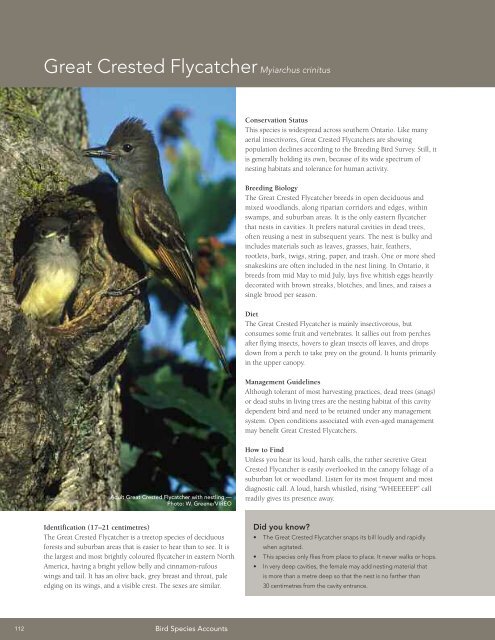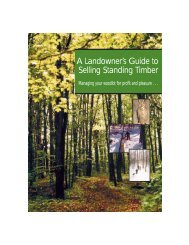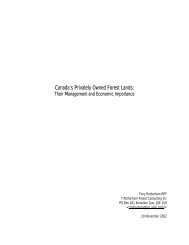A land manager's guide to conserving habitat for forest birds in ...
A land manager's guide to conserving habitat for forest birds in ...
A land manager's guide to conserving habitat for forest birds in ...
Create successful ePaper yourself
Turn your PDF publications into a flip-book with our unique Google optimized e-Paper software.
Great Crested Flycatcher Myiarchus cr<strong>in</strong>itus<br />
Conservation Status<br />
This species is widespread across southern Ontario. Like many<br />
aerial <strong>in</strong>sectivores, Great Crested Flycatchers are show<strong>in</strong>g<br />
population decl<strong>in</strong>es accord<strong>in</strong>g <strong>to</strong> the Breed<strong>in</strong>g Bird Survey. Still, it<br />
is generally hold<strong>in</strong>g its own, because of its wide spectrum of<br />
nest<strong>in</strong>g <strong>habitat</strong>s and <strong>to</strong>lerance <strong>for</strong> human activity.<br />
Breed<strong>in</strong>g Biology<br />
The Great Crested Flycatcher breeds <strong>in</strong> open deciduous and<br />
mixed wood<strong>land</strong>s, along riparian corridors and edges, with<strong>in</strong><br />
swamps, and suburban areas. It is the only eastern flycatcher<br />
that nests <strong>in</strong> cavities. It prefers natural cavities <strong>in</strong> dead trees,<br />
often reus<strong>in</strong>g a nest <strong>in</strong> subsequent years. The nest is bulky and<br />
<strong>in</strong>cludes materials such as leaves, grasses, hair, feathers,<br />
rootlets, bark, twigs, str<strong>in</strong>g, paper, and trash. One or more shed<br />
snakesk<strong>in</strong>s are often <strong>in</strong>cluded <strong>in</strong> the nest l<strong>in</strong><strong>in</strong>g. In Ontario, it<br />
breeds from mid May <strong>to</strong> mid July, lays five whitish eggs heavily<br />
decorated with brown streaks, blotches, and l<strong>in</strong>es, and raises a<br />
s<strong>in</strong>gle brood per season.<br />
Diet<br />
The Great Crested Flycatcher is ma<strong>in</strong>ly <strong>in</strong>sectivorous, but<br />
consumes some fruit and vertebrates. It sallies out from perches<br />
after fly<strong>in</strong>g <strong>in</strong>sects, hovers <strong>to</strong> glean <strong>in</strong>sects off leaves, and drops<br />
down from a perch <strong>to</strong> take prey on the ground. It hunts primarily<br />
<strong>in</strong> the upper canopy.<br />
Management Guidel<strong>in</strong>es<br />
Although <strong>to</strong>lerant of most harvest<strong>in</strong>g practices, dead trees (snags)<br />
or dead stubs <strong>in</strong> liv<strong>in</strong>g trees are the nest<strong>in</strong>g <strong>habitat</strong> of this cavity<br />
dependent bird and need <strong>to</strong> be reta<strong>in</strong>ed under any management<br />
system. Open conditions associated with even-aged management<br />
may benefit Great Crested Flycatchers.<br />
Adult Great Crested Flycatcher with nestl<strong>in</strong>g —<br />
Pho<strong>to</strong>: W. Greene/VIREO<br />
How <strong>to</strong> F<strong>in</strong>d<br />
Unless you hear its loud, harsh calls, the rather secretive Great<br />
Crested Flycatcher is easily overlooked <strong>in</strong> the canopy foliage of a<br />
suburban lot or wood<strong>land</strong>. Listen <strong>for</strong> its most frequent and most<br />
diagnostic call. A loud, harsh whistled, ris<strong>in</strong>g “WHEEEEEP” call<br />
readily gives its presence away.<br />
Identification (17–21 centimetres)<br />
The Great Crested Flycatcher is a tree<strong>to</strong>p species of deciduous<br />
<strong>for</strong>ests and suburban areas that is easier <strong>to</strong> hear than <strong>to</strong> see. It is<br />
the largest and most brightly coloured flycatcher <strong>in</strong> eastern North<br />
America, hav<strong>in</strong>g a bright yellow belly and c<strong>in</strong>namon-rufous<br />
w<strong>in</strong>gs and tail. It has an olive back, grey breast and throat, pale<br />
edg<strong>in</strong>g on its w<strong>in</strong>gs, and a visible crest. The sexes are similar.<br />
Did you know?<br />
• The Great Crested Flycatcher snaps its bill loudly and rapidly<br />
when agitated.<br />
• This species only flies from place <strong>to</strong> place. It never walks or hops.<br />
• In very deep cavities, the female may add nest<strong>in</strong>g material that<br />
is more than a metre deep so that the nest is no farther than<br />
30 centimetres from the cavity entrance.<br />
112<br />
Bird Species Accounts

















